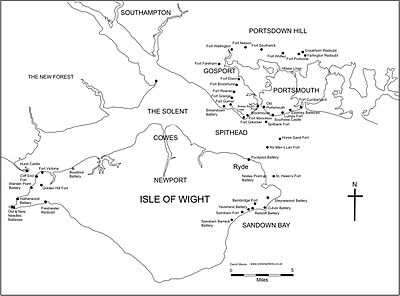
The Palmerston Forts that encircle Portsmouth were built in response to the 1859 Royal Commission dealing with the perceived threat of a French invasion. The forts were intended to defend the Dockyard in Portsmouth. Construction was carried out by the Royal Engineers and civilian contractors (under Royal Engineer supervision). In addition to the newly constructed forts, extensive work was carried out on existing fortifications.
The Portsmouth defences can be split into four distinct groups of forts, comprising four sea forts built in the Solent, a group of forts on Portsea Island, a group of forts along Portsdown Hill overlooking Portsmouth, and a group of forts on the Gosport peninsula.
As well as these forts surrounding Portsmouth, further protection for Portsmouth was provided by additional Palmerston forts on the Isle of Wight.
Solent forts
These man-made island forts were originally built to protect the eastern approaches to Portsmouth Harbour from attack by enemy forces. The four armour-plated forts were designed by Captain E. H. Stewart, overseen by Assistant Inspector General of Fortifications, Colonel W. F. D. Jervois. Construction took place between 1865 and 1880, at a total cost of £1,177,805. By the time the forts had been completed, the threat of invasion had long since passed and although the forts were armed and re-armed as technology advanced, they were never used in anger. They were decommissioned in 1956 and put up for sale in the 1960s, although they were not sold until the 1980s. The subsequent purchaser, in 2012, was Clarenco (previously known as Amazing Retreats), operated by Michael Clare. His plan was for two of the forts to be converted into hotels and one into a museum.
The restoration was completed for Spitbank Fort and No Man's Land Fort, both hotels at the time, but not for Horse Sand Fort. In 2020, the three were listed for sale.
Portsea Island forts
These forts are situated on Portsea Island, the low-lying island on which most of the city of Portsmouth is located. None of the forts were originally built as a result of the 1859 Royal Commission, but they did receive improvements because of it.
Portsdown Hill forts
These forts are located along Portsdown Hill overlooking Portsmouth, and were a response to advancing weapons technology. This new technology made it possible for shelling accurate over a number of miles to take place. The forts were intended to prevent a hostile force landing further along the coast, approaching Portsmouth from the mainland, taking the tactical high ground to the north of the dockyard. As such, the forts are designed so that all of their main weapons face inland, protecting Portsmouth from the rest of England.
- Fort Wallington
- Fort Nelson, Portsmouth
- Fort Southwick
- Fort Widley
- Fort Purbrook
- Crookhorn Redoubt
- Farlington Redoubt
Gosport forts
These are situated on the Gosport peninsula. Again, they were built to prevent an enemy force landing along the coast and approaching Portsmouth from inland, and had their main weaponry facing away from Portsmouth.
- Fort Monckton
- Fort Gilkicker
- Stokes Bay Lines
- Browndown Battery
- Fort Fareham
- Fort Gomer
- Fort Grange
- Fort Rowner
- Fort Brockhurst
- Fort Elson
See also
References
- Clarenco to operate a trio of forts in the Solent
- "History of the Solent Forts". Royal Naval Museum. Archived from the original on 12 July 2018. Retrieved 12 July 2018.
- Live in your choice of Victorian sea forts, from a boutique delight with helipad to a crumbling wreck that’s a blank canvas
External links
- Victorian Forts and Batteries
- Portsmouth forts map on Bing
- Palmerston Forts Society
- Royal Engineers Museum Archived 18 January 2007 at the Wayback Machine Coastal Defence
- Solentforts site
50°47′N 1°6′W / 50.783°N 1.100°W / 50.783; -1.100
Categories: